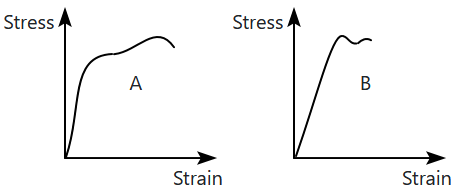The stress-strain curves are drawn for two different materials \(X\) and \(Y.\) It is observed that the ultimate strength point and the fracture point are close to each other for material \(X\) but are far apart for material \(Y.\) We can say that the materials \(X\) and \(Y\) are likely to be (respectively):
1.
ductile and brittle
2.
brittle and ductile
3.
brittle and plastic
4.
plastic and ductile
The increase in the length of a wire on stretching is \(0.04\)%. If Poisson's ratio for the material of wire is \(0.5,\) then the diameter of the wire will:
| 1. | decrease by \(0.02\)%. | 2. | decrease by \(0.01\)%. |
| 3. | decrease by \(0.04\)%. | 4. | increase by \(0.03\)%. |
The Poisson's ratio of a material is \(0.4.\) If a force is applied to a wire of this material, there is a decrease in the cross-section area by \(2\)%. In such a case the percentage increase in its length will be:
| 1. | \(3\)% | 2. | \(2.5\)% |
| 3. | \(1\)% | 4. | \(0.5\)% |
A steel wire of length \(4.7\) m and cross-sectional area \(3.0 \times 10^{-5}\) m2 is stretched by the same amount as a copper wire of length \(3.5\) m and cross-sectional area of \(4.0 \times 10^{-5}\) m2 under a given load. The ratio of Young’s modulus of steel to that of copper is:
1. \(1.79:1\)
2. \(1:1.79\)
3. \(1:1\)
4. \(1.97:1\)
The figure shows the strain-stress curve for a given material. What is Young’s modulus for this material?
1. \(7.5\times10^{11}~\text{Nm}^{-2}\)
2. \(7.5\times10^{10}~\text{Nm}^{-2}\)
3. \(7.5\times10^{9}~\text{Nm}^{-2}\)
4. \(7.5\times10^{-10}~\text{Nm}^{-2}\)
The stress-strain graphs for materials \(A\) and \(B\) are shown in the figure. Strength of material \(A\) is:
(The graphs are drawn to the same scale)
| 1. | greater than material \(B\) |
| 2. | equal to material \(B\) |
| 3. | less than material \(B\) |
| 4. | insufficient data |
Two wires of diameter \(0.25\) cm, one made of steel and the other made of brass are loaded, as shown in the figure. The unloaded length of the steel wire is \(1.5\) m and that of the brass wire is \(1.0\) m. The elongation of the steel wire will be:
(Given that Young's modulus of the steel, \(Y_S=2 \times 10^{11}\) Pa and Young's modulus of brass, \(Y_B=1 \times 10^{11}\) Pa)
| 1. | \(1.5 \times 10^{-4}\) m | 2. | \(0.5 \times 10^{-4}\) m |
| 3. | \(3.5 \times 10^{-4}\) m | 4. | \(2.5 \times 10^{-4}\) m |
The volume contraction of a solid copper cube, 10 cm on an edge, when subjected to a hydraulic pressure of \(7.0\times10^6\) Pa is: (Bulk modulus of copper is .)
1. \( 3.1 \times 10^{-2} \mathrm{~m}^3 \)
2. \(9.1 \times 10^{-3} \mathrm{~cm}^3 \)
3. \(5.0 \times 10^{-2} \mathrm{~cm}^3 \)
4. \(7.9 \times 10^{-2} \mathrm{~cm}^3\)
How much should the pressure on a litre of water be changed to compress it by \(0.10 \%?\)
(Given Bulk modulus of water, \(B=2.2\times 10^9\) N-m-2)
1. \(4.8 \times 10^6\) N/m2
2. \(2.2 \times 10^6\) N/m2
3. \(5.1 \times 10^6\) N/m2
4. \(3.3 \times 10^6\) N/m2
Hooke's law is applicable for:
| 1. | elastic materials only | 2. | plastic materials only |
| 3. | elastomers only | 4. | all of these |





